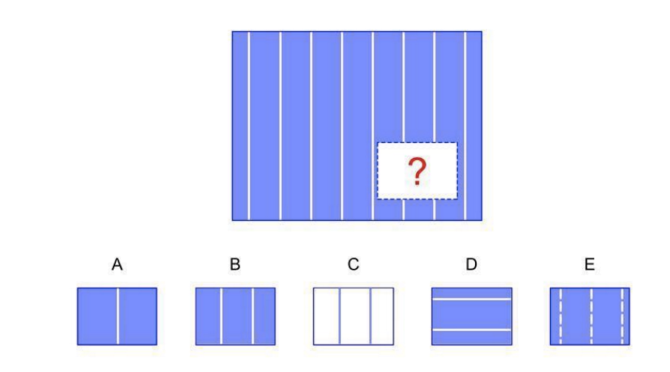The NNAT is a nonverbal test qualifying students from kindergarten through 12th grade for gifted and talented programs. The NNAT assesses students nonverbally using shapes and figures to evaluate their problem-solving abilities. Like the OLSAT, the NNAT assesses visual-spatial reasoning skills rather than a child’s school learning. The NNAT, used across various U.S. school districts, has gained popularity for admissions to gifted and talented programs. Additionally, the most recent version is the NNAT3, featuring 48 questions categorized into four distinct question types. These question types include:
- Pattern completion
- Reasoning by analogy
- Serial reasoning
- Spatial visualization
Children who are in the first grade will be assigned to the Level B exam of the NNAT. During this exam, students will come across “pattern completion”, “reasoning by analogy” and “serial reasoning” questions. Serial reasoning is a category of questions that students completing “Level A” have not yet come across. Additionally, it requires that students recognize sequences that are created by shapes and figures. These sequences change visually to form logical patterns that the student must solve for. Furthermore, these questions require that the student identify relationships between two or more images. Subsequently, they must apply the same rules to the consecutive items. Below, we provide several NNAT sample questions that are intended for the 1st grade level. Each practice question will reflect a specific category of questions that your child will come across.
Would you like to enhance your children’s NNAT confidence and familiarity? You can join TestingMom.com for valuable parent lessons, which effectively support your child’s test preparation. Additionally, these lessons complement our practice questions.
1) Pattern Completion
1st Grade NNAT Pattern Completion assesses a child’s ability to identify and complete visual patterns and sequences. Moreover, in this section of the Naglieri Nonverbal Ability Test, students encounter a series of visual patterns or sequences, with one part missing. Consequently, their task is to discern the underlying pattern and select the correct piece to complete the sequence.
This test challenges young learners to think critically, recognize relationships between visual elements, and apply their reasoning skills to solve puzzles. Success in 1st Grade NNAT Pattern Completion not only indicates a child’s proficiency in nonverbal reasoning but also contributes to their problem-solving and analytical abilities, which are valuable skills for academic success.
Example #1
Parent say to your child: Look at the pattern on top. A piece has been taken out of it. Choose the piece below the pattern that goes where the question mark in order to complete the pattern. When your child takes the NNAT, very little verbal explanation is given to them to explain how to solve the “puzzle” Instead, the child must look at the problem itself for visual cues as to how it should be solved.


Example #2
Parent say to your child: Look at the pattern on top. A piece has been taken out of it. Choose the piece below the pattern that goes where the question mark in order to complete the pattern. When your child takes the NNAT, very little verbal explanation is given to them to explain how to solve the “puzzle” Instead, the child must look at the problem itself for visual cues as to how it should be solved.
2) Reasoning by Analogy
In the NNAT Reasoning by Analogy for 1st graders, students are presented with visual elements and shapes arranged in a particular pattern. Subsequently, their task is to identify and apply analogical relationships between these visual elements to find the missing piece that completes the pattern.
This assessment challenges students to think critically, recognize similarities and relationships among visual elements, and apply logical reasoning to solve problems. Additionally, success in 1st Grade NNAT Reasoning by Analogy demonstrates a child’s proficiency in nonverbal reasoning, which is an essential skill for problem-solving and analytical thinking.
Example #3
Parent say to your child: Look at the figures on top. They go together in some way. Choose a figure from the answer row that goes with the figure(s) on the bottom the same way the figures on top go together.
3) Serial Reasoning
In the NNAT Serial Reasoning section, students encounter a series of visual elements or shapes that undergo gradual transformations across rows and columns. Consequently, their task is to discern the underlying pattern and predict the next figure in the sequence.
This assessment challenges students to think critically, observe changes in visual patterns, and apply logical reasoning to predict transformations. Moreover, success in 1st Grade NNAT Serial Reasoning demonstrates a child’s nonverbal reasoning proficiency, crucial for problem-solving and analysis.
Example #4
Parent say to your child: Look at the shapes in the boxes across the rows and up and down the columns. Do you see how they are related to each other? Can you find the answer that goes in the empty box so the designs inside the rows and columns follow a pattern?
Example #5
Parent say to your child: Look at the shapes in the boxes across the rows and up and down the columns. Do you see how they are related to each other? Can you find the answer that goes in the empty box so the designs inside the rows and columns follow a pattern?
Answers:
1.) B
2.) C
3.) D – each heart is a different color
4.) A – the 3 shapes alternate in each row. Each row has its own color
5.) B – the 3 shapes alternate in each row. Each column has its shade of the same color
